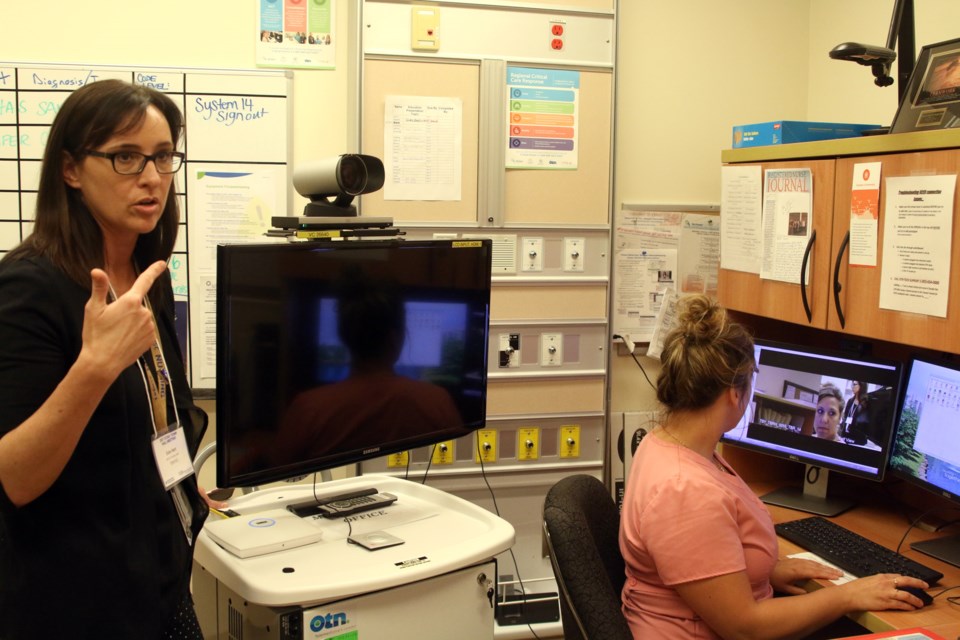THUNDER BAY - Having access to the proper healthcare, especially in critical situations, can mean the difference between life and death. For patients living in small communities throughout Northwestern Ontario, access to that care has become even easier and maybe even life-saving.
During an announcement on Tuesday, the Thunder Bay Regional Health Sciences Centre received $2 million in funding from the North West Local Health Integration Network and the provincial government for its Regional Critical Care Response Program, or RCCR.
The RCCR utilizes existing eHealth strategies to provide video conferencing and access in real-time to critical care physicians and nursing staff for patients and health care providers in remote locations.
“It’s essential,” said Laurie Heerema, chief nursing executive of the Geraldton District Hospital. “You can have all the equipment you want, you can have all the medication you want, but if you are not accustomed to using them, even if you are certified in certain courses, if you don’t use them often, which you don’t in small places, you can lose those skills.”
Heerema spent 28 years working at in the emergency department at the Thunder Bay hospital before moving to Geraldton five years ago. The transition was very eye-opening, she said, seeing how smaller communities do not have the same staff, equipment, medications, or resources to treat patients equally throughout the region.
“This RCCR program is absolutely essential because it helps physicians here at the Thunder Bay Regional Health Sciences Centre be able to see in real-time what is going on with our patients and help us provide the best possible care when we can’t transfer them out immediately,” she said.
The RCCR program began as a pilot project in 2015 in three hospitals in Northwestern Ontario. Within a year, it expanded to include all 11 hospitals throughout the region, as well as three nursing stations.
Michael Scott, chief of critical care at the Thunder Bay Regional Health Sciences Centre, said the pilot was originally funded with the North West Local Health Integration Network Northern Transformation Fund. With the funding announcement of $2 million over the next three years, Scott said having permanent funding will help the program expand.
“The biggest thing for expansion for the program is right now we are moving into Sioux Lookout and asking Sioux Lookout to look into the northern regions of all the Indigenous communities to do a similar project, but not just for critical care, for anything that needs to be done from nursing stations,” he said.
The funding for the project right now is used primarily for nursing staff, who are on-call on a 24-hour basis.
“The majority of the funding is going towards our nursing component,” Scott said. “We have funding that supplies a 24-7 RCCR nurse, it also helps out with our RTs and other allied health, to come in and go on the telemedicine conferencing that we do.”
According to Heerema, in 2015/16, the Geraldton District Hospital treated five critical patients, and in 2017 alone, staff have used the RCCR tool 22 times.
Heerema recalled one case in particular that demonstrates the importance of the system. During the ice storm last spring, an elderly patient suffered respiratory distress. He was not able to be transported to Thunder Bay and intensive care physicians assisted staff in Geraldton via real-time video conferencing.
“Because we had to keep him for 15 hours, that meant there was a lot of adjustment to drugs, we had to do a lot of suctioning of the intubation tube, and it was a lot of things we were not accustomed to,” she said. “So any kind of alarms or troubleshooting anything like that, we had the RT here, the intensivist, it was fantastic.”
The man was eventually transferred to Thunder Bay for treatment and Heerema said he is doing very well today. And while the system is saving lives across the region, Heerema said it is also a matter of simply making access to the right care more simple for patients and staff alike.
“A lot of times we just need that little bit of expertise to put us on the right path and then a lot of time we can ween the patients off the measures and keep them in our own hospital,” she said.
